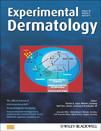High death rate in mice treated topically with diclofenac
Abstract
Abstract: Recently, 3% diclofenacnatrium gel (diclofenac) was introduced for the treatment of actinic keratoses. Data on photocarcinogenesis of topical diclofenac are limited, and we wished to investigate whether topical diclofenac can accelerate photocarcinogenesis using simulated solar radiation (SSR). Diclofenac was applied topically on the backs of hairless, female, C3.Cg/TifBomTac immunocompetent mice three times weekly followed by ultraviolet radiation (2, 3, or 4 Standard Erythema Dose) until death. There was a significant difference in survival between diclofenac-treated groups and control groups (P < 0.0001). Physical examination of the diclofenac-treated mice showed peptic ulcers, oesophageal ulcers and gastrointestinal bleeding. To be sure that these side effects were not caused by topical absorption without oral ingestion, one group of mice was wearing Elizabethian collars and was single housed. Nevertheless, these mice also had gastrointestinal side effects. We terminated the experiment after 151 days when only a few mice remained in the diclofenac-treated groups and most had symptoms of discomfort and weight loss. No tumors developed as a result of the early termination.




